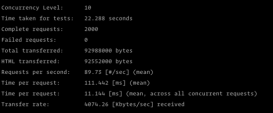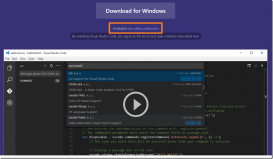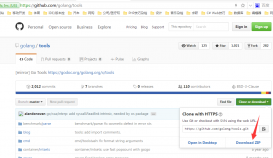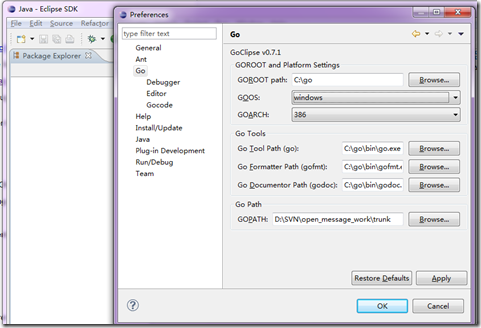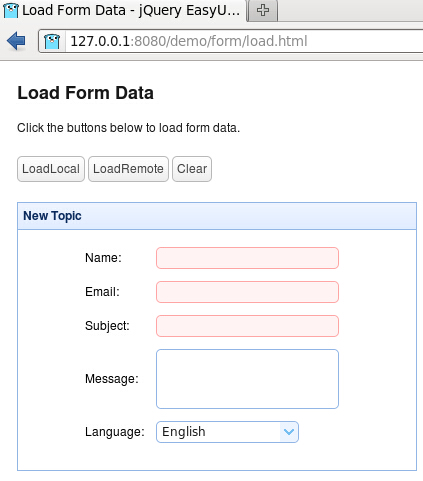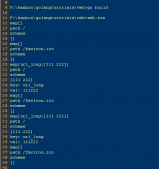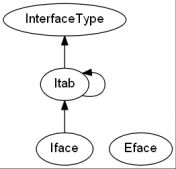如何用net/http构建一个简单的web服务
Golang提供了简洁的方法来构建web服务
|
1
2
3
4
5
6
7
8
9
10
11
12
13
|
package main import ( "net/http") func HelloResponse(rw http.ResponseWriter, request *http.Request) { fmt.Fprintf(w, "Hello world.")} func main() { http.HandleFunc("/", HelloResponse) http.ListenAndServe(":3000", nil)} |
其中核心的两个方法:
func HandleFunc(pattern string, handler func(ResponseWriter, *Request)):HandleFunc注册一个handler function对应到给定的pattern。
func ListenAndServe(addr string, handler Handler) error:ListenAndServe监听给定的TCP网络地址,接着带上handler调用Serve方法来接收请求。
在go build之后,执行编译后的文件就能在客户端看到hello world了
有了web服务,就可以制定小目标了
我认为作为第一版本,不需要复杂的设计,只需要接收到用户的请求,并且找到对应的handler,执行其逻辑,然后返回JSON响应就好了。
小目标有了,那怎么实现呢?
1.设计用户如何注册Controller和Action
据我观察,一些框架是在Controller里预先设定了GET,POST,PUT等一系列方法,负责接收GET,POST,PUT的HTTP请求。
我认为这样设计的确有其优势,因为用户只需要实现这些方法就好了,但在业务层面也有其劣势,因为我们没有办法保证负责一个页面或者功能的Controller只接收一个GET请求,如果有2个GET请求,那就需要再建立一个Controller,单单实现其GET方法。
因此我借鉴了PHP社区中Laravel注册Controller和Action的语法:Get("/", "IndexController@Index")。
用户只需要定义:
|
1
2
3
4
5
|
type IndexController struct {} func (IndexController *IndexController) Index(//params) (//return values) {} |
当然这样思考后,就给框架带入了一点动态脚本语言的特性,肯定会用到Golang的reflect库。
2.设计Path和Controller还有Action的关系容器
我运用了Golang的map,定义了map[string]map[string]map[string]string这样的数据结构
以["/":["GET":["IndexController":"Get"], "POST":["IndexController":"Post"]], "/foo":["GET":["IndexController":"Foo"]]]举例:
这个说明了在"/"这个PATH下面,有GET和POST请求,分别对应了IndexController下的Get和Post方法,在"/foo"这个PATH下面,有GET请求,对应IndexController下的Foo方法。
在接受请求时候,如果没有找到对应的方法,就返回405。
3.如何将注册了的一系列Method与PATH绑定来接收外部请求
我们可以看到,func HandleFunc(pattern string, handler func(ResponseWriter, *Request))要求的handler类型是func(ResponseWriter, *Request)),这和我们设计的functionfunc (IndexController *IndexController) Index(//params) (//return values) {}有所差距。
这时候我发现由于Golang具备First Class Functions特性,因此我们可以将函数做如下处理:
|
1
2
3
4
5
6
|
http.HandleFunc(path, HandleRequest()) func HandleRequest() { return func(rw http.ResponseWriter, request *http.Request) { // do your logic }} |
4.和encoding/json说Hi
当我们接收到function的返回值后,我们就需要对结果进行json encode,而encoding/json正是负责这个功能。 我用的是json.Marshal():
func Marshal(v interface{}) ([]byte, error): Marshal返回v的encoding结果。
如何使用
|
1
2
3
4
5
6
7
8
9
10
11
12
13
14
15
16
17
18
19
20
21
22
23
24
25
26
27
28
29
30
|
package main import ( "net/url" "net/http" "github.com/ZhenhangTung/GoGym") type IndexController struct {} func (IndexController *IndexController) Index(request map[string]url.Values, headers http.Header) (statusCode int, response interface{}) { return 200, map[string]string{"hello": "world"}} type BarController struct {} func (*BarController) Bar(request map[string]url.Values, headers http.Header) (statusCode int, response interface{}, responseHeader http.Header) { return 200, map[string]string{"GoTo": "Bar"}, http.Header{"Foo": {"Bar", "Baz"}}} func main() { var apiService = GoGym.Prepare() apiService.Get("index", "IndexController@Index") apiService.Post("bar", "BarController@Bar") controllers := []interface{}{&IndexController{}} apiService.RegisterControllers(controllers) apiService.RegisterController(&BarController{}) apiService.Serve(3000)} |
项目完整代码
|
1
2
3
4
5
6
7
8
9
10
11
12
13
14
15
16
17
18
19
20
21
22
23
24
25
26
27
28
29
30
31
32
33
34
35
36
37
38
39
40
41
42
43
44
45
46
47
48
49
50
51
52
53
54
55
56
57
58
59
60
61
62
63
64
65
66
67
68
69
70
71
72
73
74
75
76
77
78
79
80
81
82
83
84
85
86
87
88
89
90
91
92
93
94
95
96
97
98
99
100
101
102
103
104
105
106
107
108
109
110
111
112
113
114
115
116
117
118
119
120
121
122
123
124
125
126
127
128
129
130
131
132
133
134
135
136
137
138
139
140
141
142
143
144
145
146
147
148
149
150
151
152
153
154
155
156
157
158
159
160
161
162
163
164
165
166
167
168
169
170
171
172
173
|
package GoGym import ( "encoding/json" "fmt" "net/http" "net/url" "reflect" "strings") const ( GETMethod = "GET" POSTMethod = "POST" PUTMethod = "PUT" PATCHMethod = "PATCH" DELETEMethod = "DELETE" OPTIONSMethod = "OPTIONS") const ( HTTPMethodNotAllowed = 405) // APIService for now is the struct for containing controllerRegistry and registeredPathAndController,// and it is the core service providertype APIService struct { // controllerRegistry is where all registered controllers exist controllerRegistry map[string]interface{} //registeredPathAndController is a mapping of paths and controllers registeredPathAndController map[string]map[string]map[string]string requestForm map[string]url.Values} func (api *APIService) Get(path, controllerWithActionString string) { mapping := api.mappingRequestMethodWithControllerAndActions(GETMethod, path, controllerWithActionString) api.registeredPathAndController[path] = mapping} func (api *APIService) Post(path, controllerWithActionString string) { mapping := api.mappingRequestMethodWithControllerAndActions(POSTMethod, path, controllerWithActionString) api.registeredPathAndController[path] = mapping} func (api *APIService) Put(path, controllerWithActionString string) { mapping := api.mappingRequestMethodWithControllerAndActions(PUTMethod, path, controllerWithActionString) api.registeredPathAndController[path] = mapping} func (api *APIService) Patch(path, controllerWithActionString string) { mapping := api.mappingRequestMethodWithControllerAndActions(PATCHMethod, path, controllerWithActionString) api.registeredPathAndController[path] = mapping} func (api *APIService) Options(path, controllerWithActionString string) { mapping := api.mappingRequestMethodWithControllerAndActions(OPTIONSMethod, path, controllerWithActionString) api.registeredPathAndController[path] = mapping} func (api *APIService) Delete(path, controllerWithActionString string) { mapping := api.mappingRequestMethodWithControllerAndActions(DELETEMethod, path, controllerWithActionString) api.registeredPathAndController[path] = mapping} // mappingRequestMethodWithControllerAndActions is a function for mapping request method with controllers// which containing actionsfunc (api *APIService) mappingRequestMethodWithControllerAndActions(requestMethod, path, controllerWithActionString string) map[string]map[string]string { mappingResult := make(map[string]map[string]string) if length := len(api.registeredPathAndController[path]); length > 0 { mappingResult = api.registeredPathAndController[path] } controllerAndActionSlice := strings.Split(controllerWithActionString, "@") controller := controllerAndActionSlice[0] action := controllerAndActionSlice[1] controllerAndActionMap := map[string]string{controller: action} mappingResult[requestMethod] = controllerAndActionMap return mappingResult} // HandleRequest is a function to handle http requestfunc (api *APIService) HandleRequest(controllers map[string]map[string]string) http.HandlerFunc { return func(rw http.ResponseWriter, request *http.Request) { request.ParseForm() method := request.Method api.requestForm["query"] = request.Form api.requestForm["form"] = request.PostForm macthedControllers, ok := controllers[method] if !ok { rw.WriteHeader(HTTPMethodNotAllowed) } for k, v := range macthedControllers { controllerKey := "*" + k controller := api.controllerRegistry[controllerKey] in := make([]reflect.Value, 2) in[0] = reflect.ValueOf(api.requestForm) in[1] = reflect.ValueOf(request.Header) returnValues := reflect.ValueOf(controller).MethodByName(v).Call(in) statusCode := returnValues[0].Interface() intStatusCode := statusCode.(int) response := returnValues[1].Interface() responseHeaders := http.Header{} if len(returnValues) == 3 { responseHeaders = returnValues[2].Interface().(http.Header) } api.JSONResponse(rw, intStatusCode, response, responseHeaders) } }} // RegisterHandleFunc is a function registers a handle function to handle request from pathfunc (api *APIService) RegisterHandleFunc() { for k, v := range api.registeredPathAndController { path := k if !strings.HasPrefix(k, "/") { path = fmt.Sprintf("/%v", k) } http.HandleFunc(path, api.HandleRequest(v)) }} // RegisterControllers is a function registers a struct of controllers into controllerRegistryfunc (api *APIService) RegisterControllers(controllers []interface{}) { for _, v := range controllers { api.RegisterController(v) }} // RegisterControllers is a function registers a controller into controllerRegistryfunc (api *APIService) RegisterController(controller interface{}) { controllerType := getType(controller) api.controllerRegistry[controllerType] = controller} // getType is a function gets the type of valuefunc getType(value interface{}) string { if t := reflect.TypeOf(value); t.Kind() == reflect.Ptr { return "*" + t.Elem().Name() } else { return t.Name() }} // Serve is a functionfunc (api *APIService) Serve(port int) { api.RegisterHandleFunc() fullPort := fmt.Sprintf(":%d", port) http.ListenAndServe(fullPort, nil)} // JSONResponse is a function return json responsefunc (api *APIService) JSONResponse(rw http.ResponseWriter, statusCode int, response interface{}, headers http.Header) { for k, v := range headers { for _, header := range v { rw.Header().Add(k, header) } } rw.Header().Add("Content-Type", "application/json") rw.WriteHeader(statusCode) rsp, err := json.Marshal(response) if err != nil { // TODO: logging error fmt.Println("JSON err:", err) } rw.Write(rsp)} // Prepare is a fucntion prepare the service and return prepared service to the userfunc Prepare() *APIService { var apiService = new(APIService) apiService.controllerRegistry = make(map[string]interface{}) apiService.registeredPathAndController = make(map[string]map[string]map[string]string) apiService.requestForm = make(map[string]url.Values) return apiService} |
以上为个人经验,希望能给大家一个参考,也希望大家多多支持服务器之家。如有错误或未考虑完全的地方,望不吝赐教。
原文链接:https://blog.csdn.net/mengxinghuiku/article/details/65631173



